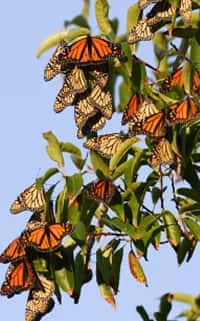It may seem like you have seen more butterflies than usual lately. With fall weather finally arriving, some butterflies migrate in order to escape the coming cold. In all the world, no butterflies migrate like the Monarchs of North America.
They travel much farther than all other tropical butterflies, up to three thousand miles. They are the only butterflies to make such a long, two way migration every year. Amazingly, they fly in masses to the same winter roosts, often to the exact same trees. Their migration is more the type we expect from birds or whales. However, unlike birds and whales, individuals only make the round-trip once. It is their children's grandchildren that return south the following fall.
Their migration is more the type we expect from birds or whales. However, unlike birds and whales, individuals only make the round-trip once. It is their children's grandchildren that return south the following fall.
Some other species of Lepidoptera (butterflies and moths) travel long distances, but they generally go in one direction only, often following food. This one-way movement is properly called emigration. When the late summer and early fall brood of Monarchs emerge from their pupae, or chrysalides, they are biologically and behaviorally different from those emerging in the summer. The shorter days and cooler air of late summer trigger changes. In Minnesota this occurs around the end of August. Even though these butterflies look like summer adults, they won't mate or lay eggs until the following spring. Instead, their small bodies prepare for a strenuous flight.
Otherwise solitary animals, they often cluster at night while moving ever southward. If they linger too long, they won't be able to make the journey; because they are cold-blooded, they are unable to fly in cold weather. Fat, stored in the abdomen, is a critical element of their survival for the winter. This fat not only fuels their flight of one to three thousand miles, but must last until the next spring when they begin the flight back north.
If they linger too long, they won't be able to make the journey; because they are cold-blooded, they are unable to fly in cold weather. Fat, stored in the abdomen, is a critical element of their survival for the winter. This fat not only fuels their flight of one to three thousand miles, but must last until the next spring when they begin the flight back north.
As they migrate southwards, Monarchs stop to nectar, and they actually gain weight during the trip! Some researchers think that Monarchs conserve their "fuel" in flight by gliding on air currents as they travel south. This is an area of great interest for researchers; there are many unanswered questions about how these small organisms are able to travel so far. Monarchs spend the winter roosting in trees at sites in Mexico and southern California. They cluster together, covering whole tree trunks and branches. As the winter ends and the days grow longer, the monarchs become more ac
Dr. Chip Taylor of the University of Kansas has continued the study of monarch migration through a tagging program called Monarch Watch. Started in 1991, Monarch Watch is a collaborative network of hundreds of thousands of students, teachers, volunteers and researchers dedicated to the study of the monarch butterfly. These participants tag tens of thousands of monarchs each year throughout Canada and the United States. Through the recovery of tagged monarchs, we have learned a great deal about the routes monarchs take and how fast they move.
tagged monarchs, we have learned a great deal about the routes monarchs take and how fast they move.
The eastern population of North America’s monarchs overwinters in the same 11 to 12 mountain areas in the States of Mexico and Michoacán from October to late March. The male monarch butterfly has a black spot on each hind wing that is made up of specialized scales. In other butterflies, similar spots emit pheromones to attract females, but scientists are not sure what function these spots serve for monarch males. These black dots are an excellent ‘male marker’ for sexing purposes.
The monarch female has noticeably thicker wing veins, which give her a darker appearance. The female’s hind wings are spotless… Monarch butterflies performing their annual migrations across North America have been called “one of the most spectacular natural phenomena in the world". Feel free to leave comments and be sure to hit the “Like” button at the bottom of this post.





